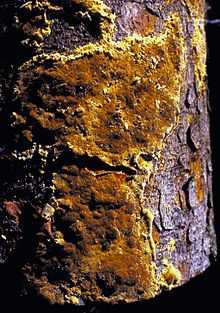Phellinus weirii
| Phellinus weirii | |
|---|---|
 | |
| Fruiting bodies of Phellinus weirii | |
| Scientific classification | |
| Kingdom: | Fungi |
| Phylum: | Basidiomycota |
| Class: | Basidiomycetes |
| Subclass: | Incertae sedis |
| Order: | Hymenochaetales |
| Family: | Hymenochaetaceae |
| Genus: | Phellinus |
| Species: | P. weirii |
| Binomial name | |
| Phellinus weirii (Murrill) Gilb., (1974) | |
Phellinus weirii is a plant pathogen causing laminated root rot in certain conifers, typically Douglas-fir and western redcedar.[1] It is widespread in the Douglas Fir Growing regions of British Columbia, Washington and Oregon.[2]
Overview
It is easily recognized when timber is cut because a brown stain will appear on the butt cut. In early stages it will be just a spot in the heart wood, but as the disease advances it will extend most of the way around the heart wood, and in extreme cases may result in a hollow stump. Usually it is not observed more than a few feet above ground level.
Losses due to the fungus are estimated at 4.4 million m3 (157 million ft3) of timber in the Northwestern United States and in British Columbia.[3]
Reduced growth rate is an attribute of tree infection.[4] Particular attention is invited to the growth ring patterns visible in the images attached.
-

Moderately advanced infection
-

Close up of Phellinus weirii infection at Apiary, Oregon
-

Hollow log at stump level---An extreme case of infection
-

View of long butt showing reduced rot a few feet up from the stump.
References
- ↑ Natural Resources Canada. "Laminated root rot". Retrieved 2008-10-04.
- ↑ "Forest Pathology: Laminated Root Rot". Canadian Forest Service. Archived from the original on 2007-04-15. Retrieved 2007-07-16.
- ↑ "Laminated Root Rot of Western Conifers". U.S. Department of Agriculture. Retrieved 2007-07-16.
- ↑ http://www.fs.fed.us/pnw/pubs/gtr349/gtr349b.pdf